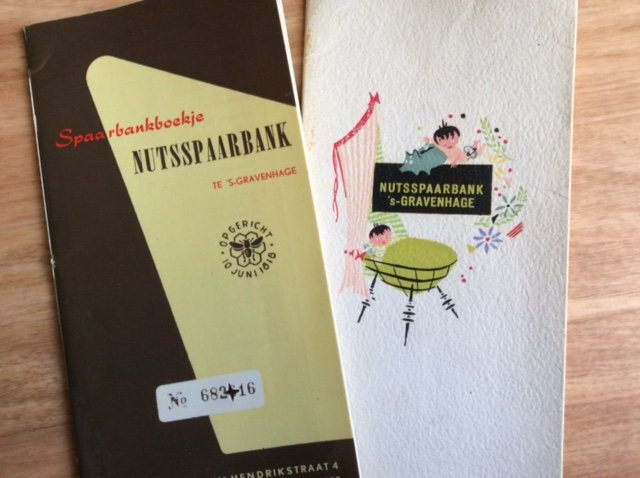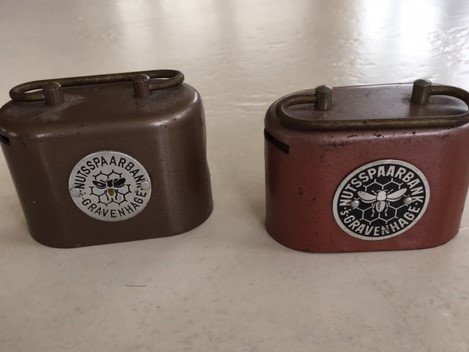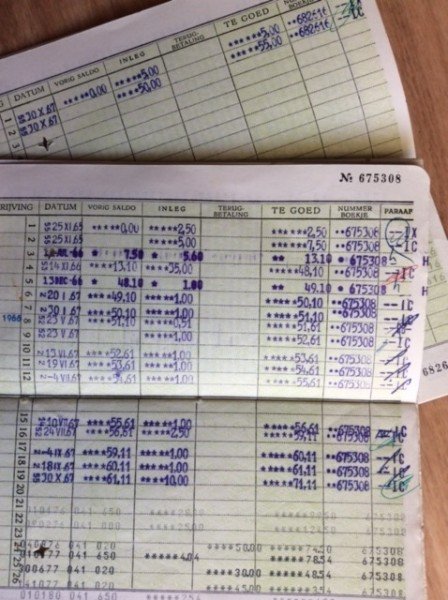
Tangible mementoes of the banking era
Anyone who saved with the Nutsspaarbank will remember the savings books. As well as the standard version, the Nutsspaarbank sometimes brought out special editions. They included a savings book to mark a birth, World Savings Day or the week that Princess Beatrix was born. They’re all tangible mementoes of a banking era that holds fond memories for many a former saver. The same applies to the special edition piggy banks.



Savings bankbooks in different colors
Most people probably had brown-yellow savings books, but there were lots of other colours too. It largely depended on changes within the bank itself and the introduction of new computers, explains former employee Bernadette van Leeuwen-Hersbach. The original savings books, before the brown-yellow version, were plain brown. The yellow was added when the bank introduced so-called ‘anchor machines’. The next colour was red, with yellow books being added to the range for high-interest accounts. Green books were for the ‘zilvervloot’ accounts that grandparents opened for their grandchildren. Modernisation at the bank heralded the arrival of red, white and blue striped books, and after the merger with VSB, they became grey.
Birth gift
Gonny Tafuni-Smit has fond memories of the Nutsspaarbank. She used a coupon in her maternity box to open an account for her newborn daughter in 1965. She received a first deposit of five guilders from the bank, and a special white cover for her savings book to show that the account was for a baby.
“It was the talk of the town. Even the midwife was talking about it. ‘Have you had your maternity box?’ she asked. And: ‘Have you taken the coupon to the Nutsspaarbank yet?’”
Prinses Beatrix
Cor van der Meer received a very special savings book when he was born on 2 February 1938, in the same week that Princess Beatrix came into the world. His parents were given a nappy basket and he got a savings book with photos of the then-Queen Juliana and Prince Bernhard. Ten guilders had been deposited into the account.
Multi-millionaire for five minutes
These days, most bank transactions are automatic. But this wasn’t always the case. Bank staff used to record withdrawals and deposits in savings books by hand. And occasionally, people made mistakes.
On 20 December 1972, for a few minutes Micky Bish was ten million guilders better off. Her savings book showed a balance of 9,999,980.60 guilders. “The woman on the till said: ‘I’ve made a mistake. I need to go and correct it.’ I didn’t realise what had happened at first”, says the 62-year-old about the spectacular ‘mistake’ in her savings book. “She corrected it within five minutes and I never gave it another thought. But later on, it was quite fun to see that amount in my savings book.”
World Savings Day
Hans Moolenbel was born in The Hague on 28 October 1937. It just happened to be World Savings Day, a special day that had been instigated three years previously to raise awareness for the importance of saving. It was an important day for the Nutsspaarbank, so Hans was given a special book to mark his birth, with five guilders in his account.
“I wasn’t allowed to withdraw the money until I was 18”, Hans remembers. “I took my piggy bank to the Nutsspaarbank on Riviervismarkt once a year as we lived on Zusterstraat, on the other side of Westeinde. I got this piggy bank when the account was opened.”
Hans continued to deposit money throughout his youth. “Just once a year, usually after my birthday. The money went into a special tray that sorted the coins before the amount was added to my balance.”
Piggy banks: irresistible to children
The Nutsspaarbank gave away lots of different piggy banks. It was a question of first come, first served. When the bank ran out, a new model and colour was produced. The piggy banks were irresistible to young savers. In fact, so irresistible that some of them even tried to prise them open.
Maja Bergman remembers taking her piggy bank to the Nutsspaarbank on Jonckbloetplein in The Hague with her brother and sister. “It was always exciting to find out who’d saved the most: my brother, my sister or me?”, says Maja. “The bank had the only key to our piggy banks. A bank employee emptied our piggy banks onto the counter and counted the money while we watched. The amounts were then written into our savings books and we went home with an empty piggy bank.”
Like many other children, Maja and her siblings couldn’t resist trying to open the lock on their piggy banks. Without success. The locks were pretty solid and Maja and her sister failed miserably. “The lock was on the bottom and we kept fiddling with it. You can still see our attempts – the locks are slightly misaligned.” But her brother wasn’t put off. “He actually managed to prise it open one day using a knife.”